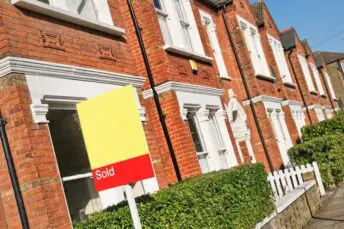Since it launched, hundreds of thousands of newly-built homes have been bought through the government’s Help to Buy scheme. In 2020-2021 alone, more than 55,000 households bought their home with a Help to Buy equity loan.
It has been a controversial scheme, with critics accrediting it with artificially inflating property prices, and many examples of buyers ending up in negative equity. But as controversial as the scheme may have been, it has helped to make homeownership more accessible for a younger generation of buyers.
So what happens when in April 2023, Help to Buy ends? With lenders offering between 4-5 times income, and average property prices at 8 times income, many first-time buyers are unable to get on the property ladder without help. Here are the alternatives to Help to Buy, from affordable mortgage options to other government and private schemes:
Mortgage alternatives to Help to Buy
Traditional guarantor mortgage
With a traditional guarantor mortgage, someone (usually a parent) takes on some of the risk of the mortgage by acting as a guarantor, allowing you to borrow more. But very few lenders now offer traditional guarantor mortgages as they have been largely replaced by Joint Borrower Sole Proprietor mortgages.
Income Boost
Tembo’s Income Boost, known as a Joint Borrower Sole Proprietor (JBSP) mortgage is a solution for those struggling to afford to buy. The idea of a JBSP is to increase the amount a buyer can borrow by including up to 4 people on the mortgage (joint borrowers). They allocate some or all of their income to the mortgage so a greater amount can be borrowed. This product is particularly useful if the buyer is likely to have a pay increase over the coming years, as the joint borrowers can come off the mortgage when it’s time to remortgage. The ‘sole proprietor’ part means that only the buyer is on the deeds of the property, so the other joint borrowers do not have ownership of the property or any legal right to it. In the event the buyer is unable to pay the mortgage, the joint borrowers would be jointly liable for it.
Deposit Boost
If, like many Brits, you are struggling to save money whilst renting, a Deposit Boost offers a way to top up your deposit or increase your budget by unlocking money from a family member or friend’s property.
A Deposit Boost is a way for a family member to support a buyer’s purchase, even if they don’t have cash savings available. The service involves two separate mortgages. The first is a remortgage taken out against the family member’s property to release money from the equity they’ve built up in their property. This is gifted to the buyer as a deposit. The second is the mortgage needed to get the buyer into their new home, with a larger deposit in hand! Unlocking £10,000 can start from as little as £22 a month for the supporting family member if they were to use an interest only remortgage.
Shared ownership options
Government’s Shared Ownership scheme
Shared Ownership is a government scheme that aims to make it easier for buyers to get on the property ladder through part owning/part renting. Essentially, the buyer pays a mortgage on the percentage of the property that they own and pays rent on the remaining amount. This means that the deposit they put down tends to be a lot lower than it would be if they were to purchase the entire property outright. This has made Shared Ownership a popular choice for those that are struggling to save large enough house deposit or have been priced out from buying.
Over time, the buyer has the option to increase their ownership stake in the property. This means they could eventually buy the property outright, and not have to pay rent. Read more about the pros and cons of the shared ownership scheme.
Home Reach
Home Reach is a part buy, part rent option on new builds. It’s similar to the government’s Shared Ownership scheme, except it is not delivered through a housing association.
You can buy up to a 75% share of the property initially, and the minimum deposit you can have is 5%. So you pay the mortgage on up to 75% of the property and pay rent for the rest to the landlord (in this case, Heylo). You can buy more shares in it (known as staircasing), until you have full ownership of the property.
There are some income restrictions. For those that live in London, you can’t earn more than £90,000. However, if you do exceed the income restrictions, Heylo also offers another service called Your Home. This is a part buy/part rent option on second-hand homes, and you will need a minimum cash deposit of 25%.
Wayhome
Wayhome offers ‘gradual homeownership’, allowing for prospective buyers to purchase a property up to 10x their income. The buyer purchases what they can afford, and Wayhome pays for the rest – you don’t need a mortgage. Instead, you pay rent for the part that you have not paid for. You can incrementally increase the amount you own; the more you buy, the less you pay in rent. It’s limited to older buildings, and you’ll need a minimum deposit of 5%, and minimum household income of £29,000.
Private alternatives to help to buy
There are a number of different private equity loan schemes that offer an alternative to the Help to Buy scheme, backed by private companies rather than the government. They are designed for home buyers wanting to boost their affordability but who don’t have a family member who can help. Much like the government’s Help to Buy scheme, these companies lend the buyer money so that they can increase their deposit. However, each scheme is slightly different, and they all have different qualifying factors.
Proportunity
Proportunity allows you to borrow between 10-25% of your purchase price, and the loan amount you can receive is based on your income and deposit savings. As a prerequisite, you’ll need at least a 5% deposit (so if you want to buy a £200,000 property, you will need at least £10,000 saved). Your affordability will also take into account any committed outgoings, such as student loan, pension contributions and credit card bills. The loan itself works in a similar way to Help to Buy, however you pay a fixed rate of interest from day one. Unlike Help to Buy, you can buy both new builds and second hand homes.
Ahauz
Unlike Proportunity, you can only purchase second hand homes with Ahauz. The initial interest rate for the equity loan is 6.99% for the first five years, however after that it may be variable to change. Ahauz allow you to borrow between £15,000 – £100,000, however you must repay the amount you borrow plus a 15% share of the increase in the value of your property when you sell.
Even by Nested
Even offers an interest free equity loan; so unlike the Help to Buy scheme, you won’t have to pay any interest throughout the mortgage and you can borrow up to £100,000. However, Even will take a larger share of any of the profit when you sell. Like Ahauz, you can only purchase second-hand homes, and any buyer is accepted as long as you don’t already own a home.
If you’re worried about the end of Help to Buy, Tembo advises on private equity loans, and family support mortgages such as the Deposit Boost and Income Boost. To see how Tembo could help you into your new home, visit our site and create a plan.





 June 26, 2025
June 26, 2025 



